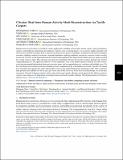CAvatar: Real-time Human Activity Mesh Reconstruction via Tactile Carpets
Author(s)
Chen, Wenqiang; Hu, Yexin; Song, Wei; Liu, Yingcheng; Torralba, Antonio; Matusik, Wojciech; ... Show more Show less
Download3631424.pdf (8.615Mb)
Publisher Policy
Publisher Policy
Article is made available in accordance with the publisher's policy and may be subject to US copyright law. Please refer to the publisher's site for terms of use.
Terms of use
Metadata
Show full item recordAbstract
Human mesh reconstruction is essential for various applications, including virtual reality, motion capture, sports performance analysis, and healthcare monitoring. In healthcare contexts such as nursing homes, it is crucial to employ plausible and non-invasive methods for human mesh reconstruction that preserve privacy and dignity. Traditional vision-based techniques encounter challenges related to occlusion, viewpoint limitations, lighting conditions, and privacy concerns. In this research, we present CAvatar, a real-time human mesh reconstruction approach that innovatively utilizes pressure maps recorded by a tactile carpet as input. This advanced, non-intrusive technology obviates the need for cameras during usage, thereby safeguarding privacy. Our approach addresses several challenges, such as the limited spatial resolution of tactile sensors, extracting meaningful information from noisy pressure maps, and accommodating user variations and multiple users. We have developed an attention-based deep learning network, complemented by a discriminator network, to predict 3D human pose and shape from 2D pressure maps with notable accuracy. Our model demonstrates promising results, with a mean per joint position error (MPJPE) of 5.89 cm and a per vertex error (PVE) of 6.88 cm. To the best of our knowledge, we are the first to generate 3D mesh of human activities solely using tactile carpet signals, offering a novel approach that addresses privacy concerns and surpasses the limitations of existing vision-based and wearable solutions.
Date issued
2024-01-12Department
Massachusetts Institute of Technology. Department of Electrical Engineering and Computer ScienceJournal
Proceedings of the ACM on Interactive, Mobile, Wearable and Ubiquitous Technologies
Publisher
ACM
Citation
Chen, Wenqiang, Hu, Yexin, Song, Wei, Liu, Yingcheng, Torralba, Antonio et al. 2024. "CAvatar: Real-time Human Activity Mesh Reconstruction via Tactile Carpets." Proceedings of the ACM on Interactive, Mobile, Wearable and Ubiquitous Technologies, 7 (4).
Version: Final published version
ISSN
2474-9567